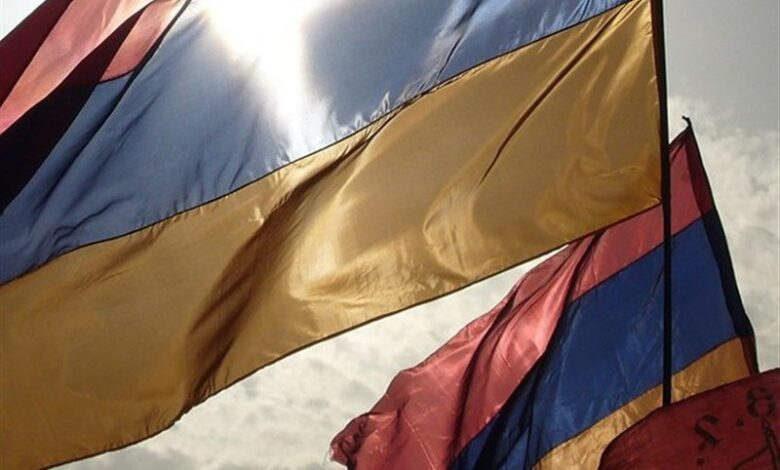Is Armenia able to withdraw from Russia’s collective security agreement?

| While Pashinyan at heart wants to steer Armenia towards Europe, he seems to understand the realities on the ground that there is no easy mechanism for Armenia to withdraw from the Collective Security Treaty or the Eurasian Economic Union. |
According to the international group Tasnim news agency, certainly in Washington and Brussels They are very pleased with Armenia’s direction towards the West and this has been strongly welcomed by them.
Armenia on December 26, 2023 at the meeting of heads of the Commonwealth of Independent States and the Eurasian Economic Union in Moscow. participated and assumed the presidency of this economic union for 2024. However, due to joining the International Criminal Court and the validity of Vladimir Putin’s arrest warrant, Yerevan cannot host the Eurasian Economic Union meetings. In order to reach the West, Armenia must first go a long way to break its ties with Russia, and it seems that the only possible way for this is “Russia’s military defeat in Ukraine”. Because as we saw in Russia’s attack on Georgia in 2008 and Ukraine last year, the Kremlin is not willing to accept the “Brexit” of countries from its Eurasian sphere of influence.
History and geography, Foreign policy and geopolitical orientation limit a country, and Armenia, which is located in the South Caucasus in the neighborhood of the Republic of Azerbaijan and Turkey, its two long-time enemies, and has no common border with its traditional ally Russia, may be most affected by the above-mentioned factors. /p>
However, since its independence after the collapse of the Soviet Union, Armenia has been aligned with Russia in all its declared and practical policies and has been placed in the orbit of this country.
In May 1992, with the end of the first Karabakh war, which resulted in the victory of the Armenians and the occupation of one-fifth of the territory of Azerbaijan, Armenia, Russia and four Central Asian countries signed the Tashkent Treaty, which was a security treaty. A year later, Georgia, Azerbaijan and Uzbekistan also joined the group of signatories of this treaty, but in 1999 they did not renew their participation in this treaty, instead they decided to align themselves with Ukraine and Moldova in the pro-Western group.
A decade later, the 6 original members joined the Tashkent Treaty, which became the Collective Security Treaty. Although Russia introduced this treaty as Eurasia’s response to the North Atlantic Treaty, or NATO, this treaty did not make any moves in response to the West’s numerous moves to expand towards the East and remained stable.
The members of the Collective Security Treaty joined it for completely different reasons. Belarus is a satellite country of Russia and, like Moscow, has an anti-Western outlook. The four Central Asian countries do not feel threatened by their neighbors, but look to the Collective Security Treaty Organization to defend their regimes. Armenia also established a security partnership with Russia and Iran to counter Turkey and Azerbaijan.
Security policies leaning towards Russia in Armenia with military relations and bilateral agreements with Moscow that were signed in August 1992 and March Signed in 1995, it gained more depth. After these contracts, Russia got two military bases in Gyumri and Yerevan airport. Armenian officers are trained in Russian military academies, and most of Armenia’s military equipment is Russian.
Before the Russian invasion of Ukraine, there were rumors of plans to expand the number of Russian bases in Armenia. In February 2021, the Minister of Defense of Armenia, Vagharshak Harutyunyan, raised the possibility of re-establishing some of the military formations of the Russian base [102] in the eastern part of Armenia, namely the Vardenis region, in the southeast of Lake Svan, bordering Azerbaijan.
In August 2010, Armenian President Serzh Sargsyan and Russian President Dmitry Medvedev signed an agreement extending the presence of Russian military bases in Armenia until 2044.
It should be pointed out that “Serzh Sargsyan” and “Robert Kocharian”, the former president and prime minister of Armenia, who are given the nickname “Karabakh clan” in the political culture of this country, in the direction of their foreign policy They are completely in favor of Russia.
Therefore, during the domination of the Karabakh clan over the political structure of Yerevan, Russia’s military presence in Armenia became even deeper. Armenia’s borders are controlled exclusively by Russian border guard troops based on the treaty signed in September 1992.
Russian border guard troops in Gyumri, Armavir, Artashat, Moghri and at Zvartnots airport. are established Of course, since last week, only the presence of the Russian border guard forces at the Yerevan airport has been suspended. . But this force is still in charge of monitoring and maintaining the security of the entire former Soviet Union.
After the ceasefire after the second Karabakh war in 2020, Russia will increase the presence of border guard forces to It expanded five points in Armenia, including two points on the border with Nakhchivan, two points on the border with Iran and one in the village of Tegh.
Russia’s military control over Armenia goes beyond this. the river In 2016, Armenia ratified an agreement with Russia to create a joint air defense system that includes all the capabilities of the Russian Air Force, including reconnaissance and surveillance, fighter jets and bombers.
In the economic sphere, Russia has expanded its control over Armenia over the past three decades. Armenia’s oil and gas and nuclear energy sectors are controlled by Russia. The Armenian labor force working in different parts of Russia is almost equal to the active labor force in this country, and the amount of money they send home is very important in the Armenian economy.
In contrast, the European Union included Armenia along with five other Soviet republics in the Eastern Partnership or Eastern Cooperation program that was unveiled in 2010. The Kremlin considers the Eastern Partnership a threat to its sphere of influence in Eurasia knew and considered the creation of the CIS customs union as a response to this European action.
After Putin returned as the president of Russia in 2012, Ukraine and Armenia pressured them not to sign agreements related to the European Union. Relatedly, in 2013, Ukrainians revolted against President Viktor Yanukovych’s withdrawal from the Eastern Partnership Agreement, while Armenians accepted President Sarkisian’s decision to do so and the country joined the Eurasian Economic Union.
Nikol Pashinyan came to power in 2018 following a popular uprising, or color revolution, against corruption and undemocratic practices by the “Karabakh clan” that has dominated Armenian politics since the early 1990s.
Pashinyan has no interest in the Collective Security Treaty Organization and considers the reason for this to be the ineffectiveness of this treaty in the second Karabakh war in 2020.
On the other hand, the Russians They rightly claim that no military action has taken place on the territory of Armenia, and for this reason, the Collective Security Treaty Organization has not intervened, because the war has taken place in the territory that is internationally recognized as Azerbaijan’s territory. Pashinyan also condemned the Russian peacekeeping forces for not intervening in favor of Armenia during the withdrawal of Azerbaijan’s short-term operations in Karabakh in mid-2023. , has sanctioned the recent summit of the Collective Security Treaty Organization and this shows Yerevan’s practical passivity in the structures of this treaty. However, despite the Prime Minister’s criticism, Armenian government officials say clearly that there are no plans to withdraw from the Collective Security Treaty or to close Russian military bases in Gyumri. The only discernible difference between the statements of the Armenian leaders is the country’s interest in establishing balance in the countries with which it has military cooperation. Countries like Iran, the United States, or some European countries.
On the other hand, Pashinyan and other Armenian officials have never raised the issue of leaving the Eurasian Economic Union. In 2016, the UK held a Brexit referendum using Article 50 of the EU Treaty, but the Eurasian Economic Union charter does not include such a mechanism and countries can only be in a customs union.
In 2014, Ukraine signed the Eastern Partnership Agreements and became part of the EU Customs Union. Armenia will not be able to rejoin the EU signing process unless it leaves the Eurasian Economic Union customs zone, which it joined in January 2015.
While Pashinyan would like to steer Armenia towards Europe, but seems to understand the realities on the ground that there is no easy mechanism for Armenia to withdraw from the Collective Security Treaty or the Eurasian Economic Union; Even if the Kremlin accepts this step, which is very unlikely and unbelievable. It’s also unclear what the Kremlin’s response would be if Armenia unilaterally shuts down Russian military bases.
Ironically, Armenia’s best chance to move west could come when Moscow Defeat Ukraine militarily. As the history of Russia in the mid-19th and early 20th centuries has shown, Russian leaders have traditionally not survived the internal turmoil caused by military defeats, which is, of course, somewhat unlikely given the field realities of the war fronts. /p>
Author: Mehdi Seif Tabrizi, researcher of Russia and Caucasus
end of message/
| © | Webangah News Hub has translated this news from the source of Tasnim News Agency |


